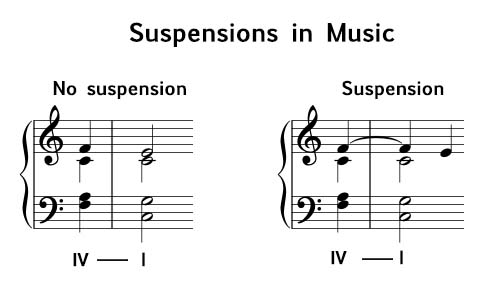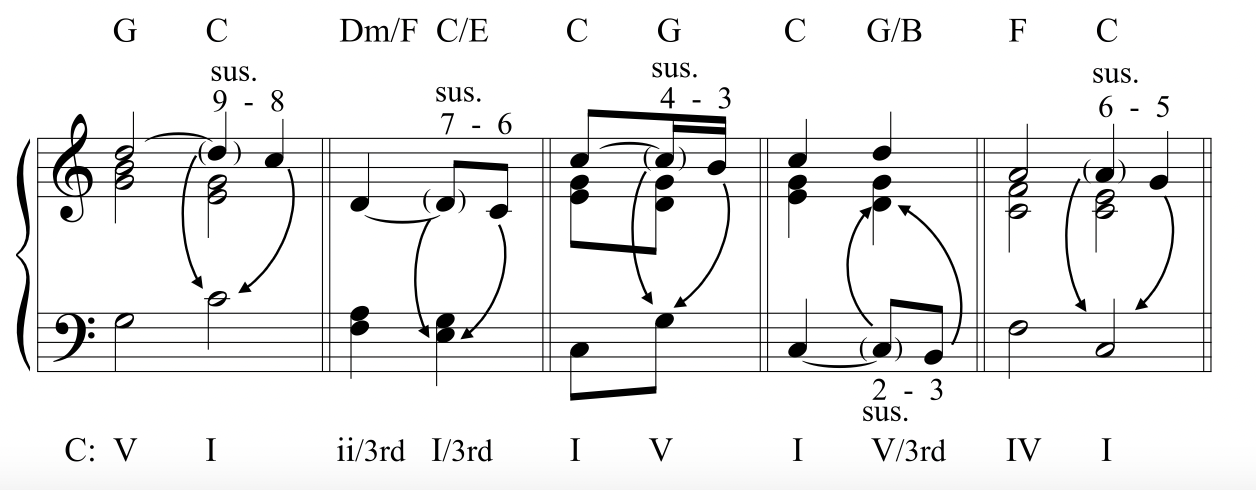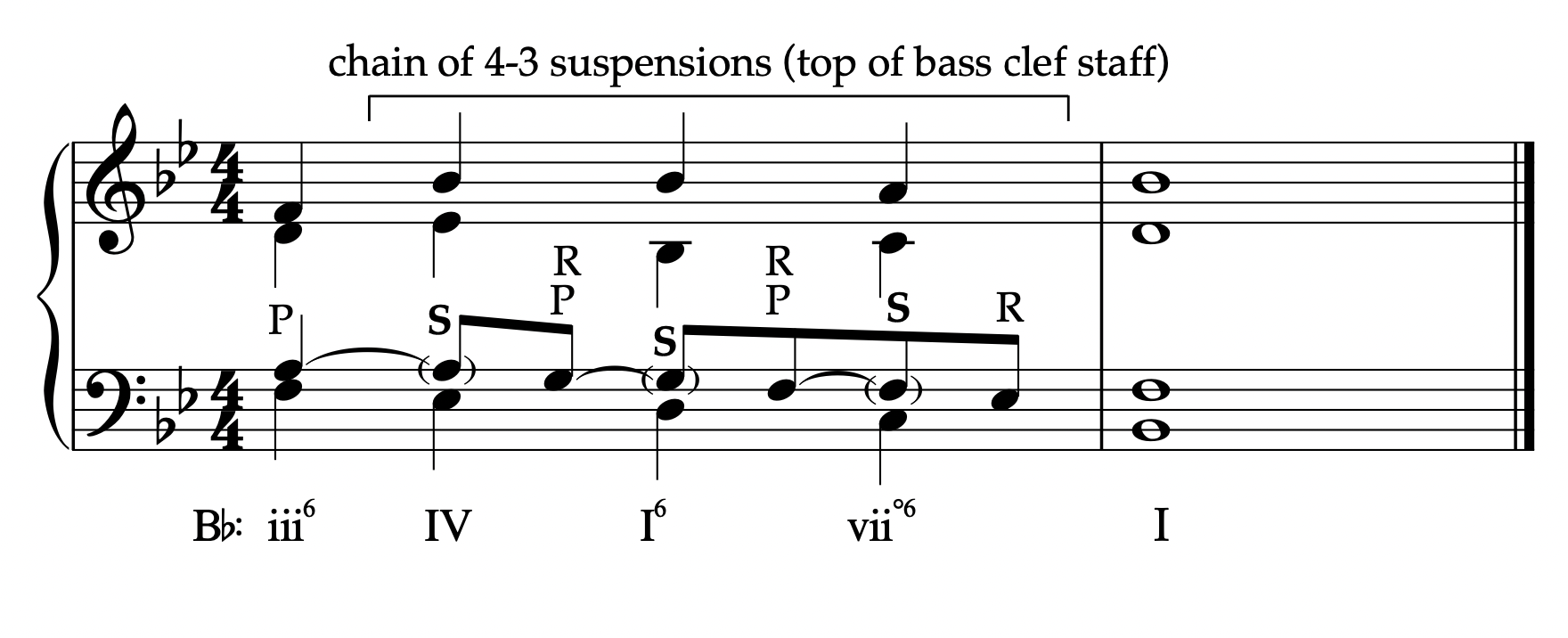6.4 Embellishing Tones: Identifying and Writing Suspensions; Identifying Retardations
7 min read•june 18, 2024
AP Music Theory 🎶
72 resourcesSee Units
Most of the non chord tones that we have learned so far, i.e. passing tones, neighbor tones, anticipations, escape tones, and appoggiaturas, mostly occur on unaccented beats, meaning that they occur on weaker beats than the harmonic beat. As an example, if the harmonic beat happens every half note, we might write a passing tone on a quarter note between the harmonic beats, or we can write an anticipation on the eighth note just before the downbeat. We have also learned how these non-chord tones, even if they could be accented, should be written for the most part on unaccented beats to follow proper voice leading rules.
In this section, we are going to talk about suspensions, which are by definition written on unaccented beats. Usually, suspensions are written on the downbeat.
Suspensions
What is a suspension? Good question! A suspension is when a chord tone from the previous chord is retained until the downbeat of the next chord, and it resolves by step to a chord tone on an unaccented beat. Usually, when we refer to suspensions, the suspended note is resolving down by step. If the suspended note is resolving upwards, we call that a retardation.
Let’s look at an example:

Image via Music Theory Academy
In this example, we are in C Major, and the soprano voice contains the suspension. We see that the F, which is the root of the chord in the IV chord, resolves down to an E, which is the third of the chord in the I chord. We might denote this as a 4-3 suspension in figured bass notation, since the fourth above the bass resolves to the third above the bass. However, usually, 4-3 suspensions are reserved for a special type of suspension when voice leading from a V7 chord to a I chord at a cadence. It is rare to see 4-3 suspensions outside of this context. We’ll go through 4-3 suspensions in more detail later in this study guide!
Just like other non chord tones, suspensions are necessarily dissonant. Even when we write a suspension when moving from a IV chord to a I chord (which we might expect to be consonant, since there are several consonant intervals among chord tones in IV chords and chord tones in I chords), we still notice the dissonant Major 2nd between F and G.
When writing suspensions using 18th-century-style music conventions, it is a good idea to avoid putting this dissonant interval in adjacent voices. For example, in the example, we have the G in the tenor and the F in the soprano. If, somehow, the G was in the alto, the chord would not sound good. Luckily, it is hard to put dissonant intervals in adjacent voices when writing suspensions because we should be maintaining proper spaces between the voices. However, this voice leading rule is something to watch out for.
Denoting Suspensions in Figured Bass
Suspensions are classified by the interval between the suspended note and the bass of the chord. For example, in a 9-8 suspensions, the suspended note is a 9th away from the bass (remember that an interval of a 9th is the same as an interval of a 2nd), and it resolves downward to be an 8th, or a perfect octave, away from the bass.
For example, if we are moving from a viio chord to a I chord in F Major, we might have a suspension of the 3rd of the viio chord resolving downward to the root of the I chord. Remember that if we are doing this, we still have to resolve the leading tone up, so the root will be doubled somewhere else, and if the vii chord is inverted, as it almost always is, we will have to have three iterations of the root in the I chord. This is usually okay if the I chord is in root position. However, in order to resolve the tendency tones in the vii chord, the chordal seventh (which is the 6th scale degree) must resolve downwards to the fifth. This means that all voices have to be present in the I chord, since if we are to omit a voice, it should be the fifth of the chord.
9-8 suspensions are quite common in other contexts, though, along with 4-3 suspensions. 7-6 suspensions are sometimes common, as they can be used in a iii-vi progression in Major when the iii and vi are used to prolong the tonic, or a V-i6 progression in minor, when the 3rd of the V is suspended and resolves down to the tonic.
Less common are 6-5 progressions, although they can be used in IV-I or iv-i progressions (the iv-i progression isn’t used often in minor keys, though), where the third of the IV chord is suspended and resolves down to the fifth of the tonic chord.
We can also write suspensions in the bass line. Here is an example:

Image via https://musictheory.pugetsound.edu/mt21c/Suspension.html
Notice that rather than the scale degrees moving downwards, they move upwards. For example, we now have a 2-3 suspension.
Where are these numbers coming from? In this case, the 3 comes from the fact that the B is the 3rd of the chord, which is a B in the case of the V chord. We write the 2 to denote that the suspension is in the bass, and that the notes are moving downward. This is mostly just a convention that you have to memorize – if you are writing a suspension in the bass, then the first number should be one less than the other number.
4-3 Suspensions
4-3 suspensions deserve a special section because they are usually used in cadences – especially V7-I cadences, where the chordal seventh of the V7 chord, which is the fourth scale degree, is suspended before resolving down to the 3rd of the I chord.
Sometimes, you might also see a 4-3# cadence, meaning that the 3rd of the I chord is raised by a half step. This is common when you modulate from a minor key to a Major key with the same tonic. For example, if you’re modulating from d minor to D Major, a 4-3# cadence would involve suspending the G in a the dominant seventh chord, and resolving it down to the F# in a D Major tonic chord.
Chains of Suspensions
A chain of suspensions refers to a series of suspensions that occur in succession in a musical piece. It is a technique used to create a sense of harmonic tension and release. In a chain of suspensions, each note of a chord is suspended one at a time and then resolved. For example, in a C major chord, the D (2nd) is suspended and then resolved, followed by the suspension and resolution of the G (5th), and then the suspension and resolution of the C (root). This creates a sense of progression and motion in the harmony, and can be used to add interest and complexity to a piece of music.
Here is an example of a chain of suspensions:

Image via learnmusictheory.net
It is important to note that the chain of suspensions is not limited to a specific type of suspension and could involve different types of suspensions like 2-3, 4-3, 7-6 etc.
It's also good to be mindful of the overall harmonic rhythm and not overuse the technique, because it could become too predictable and lose its effect. If done correctly, however, chains of suspensions can create a really beautiful effect. Debussy used this technique quite often.
Rearticulated Suspensions
In all of the examples we have seen so far, the suspended note has been tied to the previous note. If you don’t quite remember what that means, recall that a tie is a type of articulation in music where a note is held for the duration of the two notes that are tied together. For example, two quarter notes tied together means that the note is held for the duration of two quarter notes, i.e. a half note.
In a rearticulated suspension, the suspended note is not tied to the previous note. In order to be classified as a suspension, the voice still has to retain the note (i.e. the preparation note must be the same as the suspended note). However, you rearticulate the suspended note, meaning that you play it again when you get to the harmonic beat.
You might be wondering: why are the notes tied together if you could just write a longer note. For example, in the example above, the suspended note is written as a quarter note tied to an eighth note. We could have just as easily written this rhythm as a dotted quarter note. However, when writing music, it is considered bad practice to obfuscate the harmonic beat. In other words, if the harmonic beat occurs every quarter note, we shouldn’t “overwrite” the beat by adding one note that lasts longer than the harmonic beat and then interrupting the harmonic beat with another eighth note.
When writing suspensions, you should also follow this convention. This way, someone analyzing the piece or playing the piece has an easier time understanding that the note is suspended, and they can easily identify the harmonic beat.
Browse Study Guides By Unit
🎵Unit 1 – Music Fundamentals I (Pitch, Major Scales and Key Signatures, Rhythm, Meter, and Expressive Elements)
🎶Unit 2 – Music Fundamentals II (Minor Scales and Key Signatures, Melody, Timbre, and Texture)
🎻Unit 3 – Music Fundamentals III (Triads and Seventh Chords)
🎹Unit 4 – Harmony and Voice Leading I (Chord Function, Cadence, and Phrase)
🎸Unit 5: Harmony and Voice Leading II: Chord Progressions and Predominant Function
🎺Unit 6 – Harmony and Voice Leading III (Embellishments, Motives, and Melodic Devices)
🎤Unit 7 – Harmony and Voice Leading IV (Secondary Function)
🎷Unit 8 – Modes & Form
🧐Exam Skills
📚Study Tools

Fiveable
Resources
© 2025 Fiveable Inc. All rights reserved.